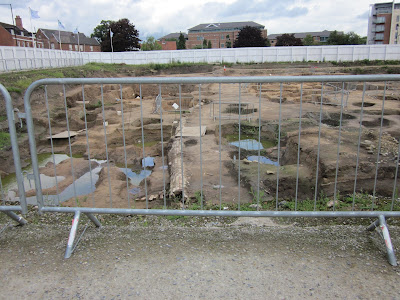You will find this hard to believe, but the mindboggling fact is that our readership figures go down when we post rants about mixer taps. It's true! To boost our flagging readership, therefore, we thought we'd give you a metaphorical vitamin injection, in the form of a revitalizing history lesson.
We went on a Historic Toilet Tour of York, arranged by a charming and extremely knowledgeable guide from York Walk. This tour starts with Roman toilets, guides you through Anglo-Saxon and Viking cesspits, continues to medieval garderobes and drains, and finishes up with Victorian toilets (or the lack of them). Most informative and enjoyable - we can't recommend this tour warmly enough!
Here's a picture our guide showed us of a typical Roman latrine, the setup of which we have mentioned before. This cosy arrangement incorporates communal benches with holes atop a drain, flushed by water, often waste water from a bath. Sponges on sticks, soaked in vinegar, were used as hygienic toilet paper (though perhaps uncomfortable if one suffered from piles).
 |
| Veni, vidi, cacavi |
According to Wikipedia, Catullus 23 contains the lines:
- Culus tibi purior salillo est, nec toto decies cacas in anno.
- ("Your arse is purer than the salt-cellar; you probably only take a dump ten times a year.")
 |
| York's multangular tower, the base of which is Roman |
 |
| Stones, pottery shards and scallops like these have been found in medieval latrines, indicating their use as "bottom scrapers" |
At Kings Manor, we had the fascinating fact pointed out to us that this tiny window used to be the outflow of a garderobe, which Henry VIII was too fat to get into! Moreover, we were delighted to be informed that when this solid monarch visited York, he was constipated for two weeks.
 |
| Kings Manor garderobe |
 |
| Henry VIII's excrement never hallowed this wall; he was too fat to get into the bog |
During the Middle Ages, it was fairly common to stipulate the building of a public privy in your will. Thus, people could sit, shit and pray for your immortal soul. With the Reformation, however, this laudable practice was flushed away, and it wasn't till the 19th century that public lavatories started becoming common again - for men, that is. The assumption was that respectable women didn't roam the streets anyway, and so had no need for public toilets. Also, fashions dictating large skirts may have made it possible for women to do their business without anybody noticing.
However, in 1896 the first public toilet for women was built in York - in Silver Street, where public toilets were reintroduced recently (it costs 40 p to spend a penny). However, this location was not unproblematic - right opposite was a lavatory for men, and there were complaints from the ladies concerning lewd and unsuitable comments from the gentlemen, whose minds were apparently inflamed by the thought of the ladies going to the toilet.
 |
| Silver Street, site of inflamed passions |
In the Richard III Museum in Monk Bar you can view this garderobe.
 |
| This toilet is no longer in use, however inviting it may look |
Another garderobe remains incorporated into the city wall.
 |
| A toilet in the city wall can provide useful ammunition in case of an attack |
 |
| Cliffords Tower, likewise, had a garderobe |
Towards the end of the tour, we went to the archaeological dig at Hungate to peep through the fence at what is being unearthed - Victorian drains! Hungate was a slum in the 19th century, and so there is probably all kinds of crap to be dug up here.
 |
| Archaeologists and Victorian plumbing |
 |
| Hungate: a Victorian sewage pipe |
 |
| You know you want it: a close-up of the Victorian sewage pipe |
Last, but not least, let us tell you about the Lloyd's bank coprolite. This was a 23 cm long Viking turd found in 1972 on the site of Lloyds bank.
 |
| Many people had their view of bankers confirmed |
That, dear readers, concludes our coprophilic tour of York. However, if you find your appetite irreversibly whetted, we recommend this highly informative book:
 |
| We got our copy from the York Walk tour guide. E-mail info@yorkwalk.co.uk if you feel you can't live another day without one. |
Related Reading
Let's Get Medieval: King's Manor Toilet
Revisiting Academia: King's Manor, Main Toilets
The Roman Bath Museum - Crap on a Stick
Nunc Est Lavandum - Bath-Time
Jorvik: In Rude Health
World Toilet Day 2011: Taking Our Baths and Our Women
Saturday on Silver Street


Great post! It's nice
ReplyDeleteHilarious. you have a great page.
ReplyDelete